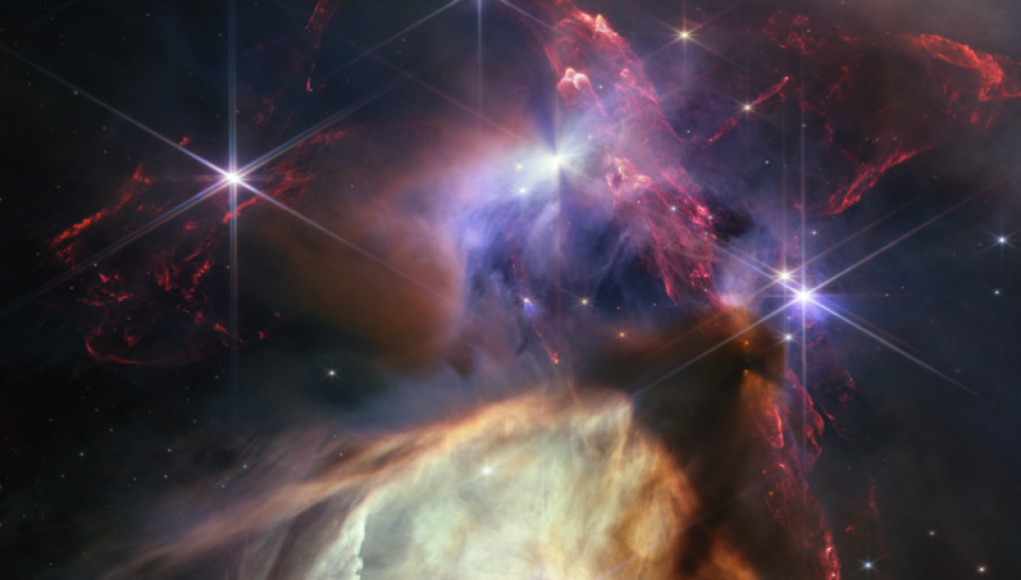To commemorate the first year of scientific operations by the James Webb Space Telescope, NASA has released a stunning new image of a stellar nursery.
The photo is absolutely breathtaking. It possesses a captivating beauty that could easily grace the walls of a prestigious museum, resembling a masterpiece created by a collaboration of talented impressionistic and modern artists. However, this image is not a work of fiction; it is a real depiction of the mesmerizing process of stars being born, a mere 390 light years away from our planet. Welcome to the Rho Ophiuchi cloud complex, the closest star-forming region to Earth.
Thanks to the proximity of this celestial nursery and the extraordinary scientific instruments of the James Webb Space Telescope, we are now able to witness these awe-inspiring phenomena with unprecedented clarity. The level of detail captured in this image, showcasing approximately 50 stars, is truly remarkable. It represents the culmination of the Webb’s achievements over the past 12 months and offers a glimpse into the groundbreaking discoveries it promises to unveil in the next decade or two.
This image provides us with a revelatory view of our own distant past. Our Sun and Solar System came into existence more than 4.5 billion years ago when a molecular cloud collapsed, giving birth to our radiant star. As the Sun formed, it was surrounded by a vast disk of leftover material, spinning gracefully. Over time, this material coalesced to form the planets, including gas giants like Jupiter and rocky worlds like our beloved Earth. This cosmic dance set the stage for the emergence of life on our planet hundreds of millions of years later.
Advertisement
Now, after billions of years, humanity has evolved, developing civilization, science, and technology that finally allows us to gaze outward with unparalleled precision, witnessing this very process unfold across the vast expanse of the cosmos. With the James Webb Space Telescope, we are privileged to observe the birth of brand-new stars and the formation of protoplanetary discs, as if we are witnessing the eternal cycle of life itself.
There are captivating details hidden within the colors of this photograph. Many of the stars captured in this image are similar in size to our Sun. However, the center of the image is dominated by a larger star, S1, surrounded by ethereal clouds of gas. This star has carved a celestial bubble within these clouds, emitting energetic ultraviolet photons, resembling a figurative candle illuminating the darkness.
Further away from this central star and its celestial cavity, we encounter orange-ish clouds. According to the astronomers of the Webb telescope, these clouds contain organic compounds known as polycyclic aromatic hydrocarbons. These carbon-rich compounds may hold the key to the genesis of life, although scientists remain uncertain. Nevertheless, what we are witnessing is not only the birth of new star systems but also the potential building blocks of life itself.
Another striking feature of this photograph is the presence of large, red bands of material running vertically down the right-hand side and across the top. These are proto-stellar outflows, appearing darkly red due to the collision of molecular hydrogen with interstellar gas.
“Webb’s image of Rho Ophiuchi allows us to witness a very brief period in the stellar life cycle with newfound clarity,” said Klaus Pontoppidan, the Webb project scientist at the Space Telescope Science Institute in Baltimore, Maryland. “Our own Sun experienced a similar phase long ago, and now we possess the technology to witness the beginning of another star’s extraordinary journey.”
Truly, it is a breathtaking story to behold.
NASA’s James Webb Space Telescope (JWST) is providing a groundbreaking opportunity to observe humanity’s ancient past, not just our solar system but galaxies and regions of space far beyond.
This powerful telescope is capable of observing faint and distant objects, allowing us to get an unprecedented look at the origins of our Universe. Its unprecedented sensitivity means that it can detect very faint signals from some of the oldest stars in the Milky Way and other galaxies, as well as intergalactic gas clouds which contain some of the earliest elements in the cosmos.
The advanced optics and infrared sensors of the JWST allow it to see much farther back in time than any other telescope. This allows us to observe objects that were created shortly after the Big Bang, more than 13 billion years ago. By observing these extremely distant objects, scientists can learn about the conditions of the early Universe, as well as its evolution over time.
By using the JWST to observe some of the faintest objects in the Universe, scientists are able to piece together the history of the cosmos. This allows us to gain a greater understanding of the birth and evolution of galaxies, stars, and ultimately ourselves.
The JWST is an invaluable tool in helping us unravel the mysteries of our ancient past, and its discoveries will help us answer some of the most fundamental questions about who we are and where we come from.




















